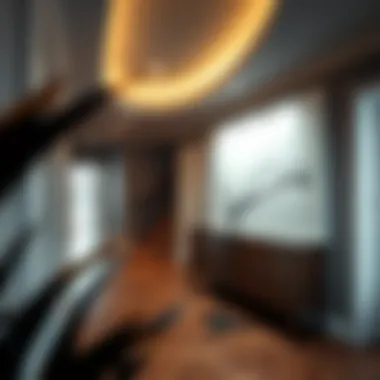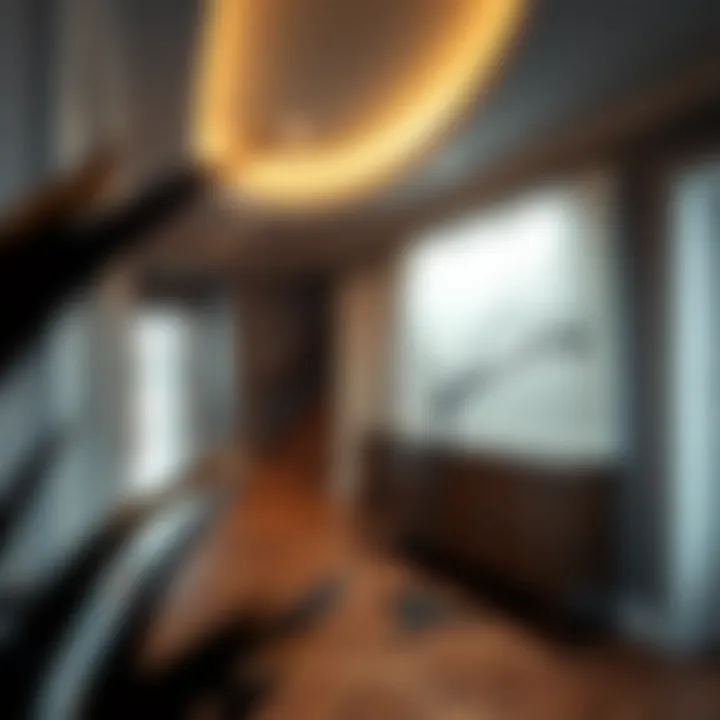Exploring Oversized White Wall Art in Design


Intro
Oversized white wall art holds a unique position in today’s interior design landscape. It plays a pivotal role in shaping the aesthetic feel of a space while also engaging homeowners’ psychology. When we think about design, we often focus on the practical aspects—furniture arrangement or color schemes. However, art, and specifically oversized white wall art, can often be the missing link that transforms an ordinary room into an extraordinary one. Its ability to expand visual perception and create a sense of tranquility is nothing short of remarkable.
In this guide, we will delve into the nuances of oversized white wall art and why it stands out in contemporary decor. From identifying current trends in furniture styles and how they complement the art to purchasing tips and maintenance advice that ensure longevity, this article aims to provide a thorough understanding of this art form. Whether you are a homeowner seeking to refresh your living area, a designer looking for inspiration, or a DIY enthusiast wanting to explore the limits of creativity, this guide offers insights designed to cater to all.
Furniture Trends and Styles
When incorporating oversized white wall art, understanding current furniture trends and styles will enhance the decor synergy within a space.
Current Trends in Furniture Design
The furniture landscape has seen a shift towards minimalism, where less truly becomes more. Clear lines and open spaces dominate, allowing oversized white pieces to stand out. Some current trends include:
- Sustainable Designs: Many homeowners are now gravitating towards furniture that is created with environmentally-friendly materials. This trend complements white art, aligning with the clean aesthetics.
- Multifunctional Pieces: The rise of smaller living spaces has necessitated clever designs that serve multiple purposes without cluttering. Incorporating white wall art can provide a focal point amidst several functions in one room.
- Organic Shapes: Natural curves and forms in furniture are increasingly appealing, promoting a seamless flow with softer design elements, including oversized wall art.
Popular Furniture Styles and Their Characteristics
Different furniture styles bring distinct characteristics that can heighten the impact of oversized white wall art. Here are some of the key styles:
- Scandinavian: Minimalistic and functional, this style often features light hues, allowing oversized white art to integrate seamlessly.
- Industrial: Raw materials and urban elements create a stark environment. White wall art injects a sense of calm and sophistication into this otherwise gritty backdrop.
- Modern Farmhouse: This style combines rustic charm with modern elements. Oversized white wall art can provide an elegant contrast, grounding the often vibrant patterns and textures.
- Mid-Century Modern: Vibrant colors and vintage pieces characterize this style. Pairing an oversized white piece can balance the boldness while providing a visual pause.
The right balance between art and furniture can create a harmony that feels both inviting and uniquely personal.
In considering the art's placement alongside furniture styles, homeowners should seek not just to fill space but to craft an ambiance that resonates with their personal preferences and showcases their unique taste.
Buying and Maintenance Guides
Entering the realm of oversized white wall art can be exciting yet overwhelming, especially when considering purchase nuances and upkeep requirements.
Essential Tips for Purchasing Furniture
Here are some useful tips to consider:
- Dimensions Matter: Always take measurements before purchasing to see how the art piece interacts with both furniture and space dimensions. A piece may look grand in a store but may feel overwhelming on your wall.
- Consider the Theme: Align purchasing decisions with the existing decor theme to prevent inconsistency. Oversized white wall art works well with various themes, but the context is crucial.
- Material Quality: Invest in pieces made with durable materials to ensure they withstand the test of time, especially in high-traffic areas.
Maintenance and Care for Different Furniture Materials
Maintaining both oversized art and furniture requires tailored approaches, particularly when it comes to materials. Here’s a brief guide:
- Wood: Regularly clean with a soft cloth and avoid water exposure. Use coasters to minimize damage from drinks.
- Fabric: Vacuum frequently and address stains promptly to maintain cleanliness.
- Metal: Wipe down with a damp cloth and dry immediately to prevent corrosion.
Having these considerations in mind can ensure that both your oversized wall art and surrounding furniture remain eye-catching and inviting for years to come.
By understanding the interplay between oversized white wall art and furniture styles, one can not only enhance aesthetic appeal but also create spaces that resonate on a psychological level, fostering comfort and style.
Understanding Oversized White Wall Art
Oversized white wall art is gaining traction in modern interior design. This trend is far from superficial; it represents a shift in how we perceive and decorate our living spaces. Understanding the essence of oversized white art is crucial for homeowners and designers alike, as it offers profound implications for aesthetics and emotional resonance in a home.
Definition and Characteristics
Oversized white wall art typically refers to artworks that are significantly larger than conventionally sized pieces, designed to command attention on spacious walls. Characteristics of these artworks include:
- Dimensions: Often exceeding 60 inches on the shortest side, making them the focal point of any room.
- Color Palette: Dominantly white, which can vary in shades from bright, crisp whites to softer off-whites, incorporating texture and depth.
- Materiality: This art can be composed of various materials, such as canvas, metal, or mixed media, each contributing unique tactile qualities that enhance visual impact.
The significance of this definition lies in its practical aspects. Homeowners should consider how the size and color influence the room's overall vibe. A large, white piece can make a room feel airier and more spacious or stark and minimalist, depending on its surrounding decor.
Historical Context
The roots of oversized art can be traced back to various art movements. In essence, this style resonated during the modernist period, where artists like Jackson Pollock and Mark Rothko refashioned the scale, aiming to evoke emotional responses through their large canvases. Yet, oversized white art transcends single styles or eras; it is also a nod to minimalism, where "less is more" reigns supreme.
In recent decades, the trend of large white art has picked up momentum. Art educators and critics note that with increased urbanization and the wonder of open spaces in architecture, the purpose of art has shifted from mere decoration to creating an experience in living spaces. Today, oversized white wall art serves as a bridge between the past's artistic intentions and contemporary design practices, reflecting not just aesthetic preferences but also changing lifestyles.
Cultural Significance
Culturally, oversized white wall art holds a mirror to current societal values and expressions. It embodies concepts such as purity, simplicity, and openness. With the emphasis on minimalism in modern design, white artworks often symbolize tranquility and peace, carving out a sanctuary within bustling urban environments.
Furthermore, oversized art is often a conversation starter. A single large piece can evoke a variety of interpretations, inviting dialogue among guests and creating connections within the home. In spaces where many cultures converge, these artworks can symbolize unity and diversity, promoting a sense of belonging.
"The beauty of oversized white wall art lies not merely in its size, but in its ability to transform a space emotionally and culturally."
In summary, understanding oversized white wall art is essential for appreciating its multifaceted roles in contemporary homes. It extends beyond superficial trends, delving into the realms of historical art movements and cultural meanings. As we further explore this topic, we’ll unveil just how to incorporate these large-scale pieces into diverse decorating styles, making your home not just visually stunning, but rich in narrative as well.
The Role of Color in Oversized Art
Color plays a pivotal role in the world of oversized white wall art. It extends beyond simply being a visual feature and dives into the very essence of how art interacts with its environment. The use of color—or lack thereof in this case—affects the emotional tone a space carries. In the realm of oversized art, white becomes a canvas that can reflect, absorb, or contrast with its surroundings. It’s important to understand these dynamics in order to appreciate fully the potential impact oversized art pieces may have in various decor styles.
Psychological Effects of White
White might seem straightforward, but its psychological implications are anything but simple. On one hand, white evokes a sense of purity and tranquility. It brings clarity to a room, providing an open and airy feel that can alleviate feelings of confinement often associated with smaller spaces. Many homeowners favor white art pieces for their ability to create an inviting atmosphere, allowing light to bounce around while keeping visual distractions at bay.


However, it is vital to note that the impression of white can differ significantly depending on the lighting and surrounding colors. For instance, in a room flooded with natural light, oversized white art can appear almost luminous, giving a sense of buoyancy. Conversely, in dimly lit areas, white may take on a starkness that could lead to coldness if not balanced carefully with warm undertones or softer textures. Thus, understanding how white interacts psychologically with viewers enhances the selection and placement of oversized art pieces, ultimately affecting mood and comfort in the space.
"White is not just a color; it's a fresh canvas where your imagination can paint zero limits."
Accentuation through Contrast
The juxtaposition of oversized white wall art against contrasting elements introduces another layer of complexity. It isn't merely about placing a white piece against darker hues; it’s the exploration of how these two extremes interact. For example, a large white canvas or sculpture hung in a room filled with rich, vibrant furnishings can create a stunning focal point that draws the eyes and sparks conversation. The contrast does more than just wow onlookers; it emphasizes the details of both the art and the surroundings.
With furniture and decor that showcase darker tones or intricate patterns, oversized white wall art serves to balance and offset busier textures, providing visual relief. This type of placement encourages harmony within disorder, appealing to that classic sense of aesthetics where simplicity finds its footing among complexity.
To explore the nuances of accentuation further, consider the following aspects:
- Choosing Surrounding Elements: Select furniture and decor that either complement or starkly contrast the oversized white art to enhance viewing pleasure.
- Light Sources: The perception of both white art and contrasting elements can shift dramatically with various light conditions—experimenting with different illuminations can yield uniquely beautiful outcomes.
- Space Planning: The placement of oversized white art in relation to furniture affects how well it stands out. Using negative space wisely can enhance its impact.
Different Styles of Oversized Wall Art
Oversized wall art is not just about size; it's about evoking emotions and creating atmospheres through various styles. Each style brings its own personality to a space, reflecting the tastes and sentiments of the homeowner. The choice of style can impact not only the aesthetics of a room but also how individuals interact with the space. Let’s explore some distinct styles of oversized white wall art that can make a statement in any environment.
Abstract Art
Abstract art serves as a window into the artist's imagination, often transcending literal representation. When oversized, this style can radically transform a wall into a striking focal point. This type of art allows for free interpretation, often engaging viewers in deep personal reflection. It can invoke feelings ranging from serenity to chaos, depending on the colors and forms used. Abstract pieces also adapt well to changing trends in decor, making them a versatile choice for homeowners.
- Benefits:
- Encourages personal connection and interpretation
- Versatile in many interior styles
- Can convey emotions that resonate with viewers
Photography
Photography brings another layer of realism to oversized art. When significant photos are blown up, they elevate ordinary moments to extraordinary pieces of art. This technique not only draws attention but also sparks conversations. Whether it’s a stunning landscape or a candid moment captured in time, oversized photographic prints can evoke nostalgia or inspire wanderlust.
- Consideration:
- Look for high-resolution images to maintain clarity at large sizes
- Choose subjects that resonate with your overall decor strategy
A carefully selected photograph can serve both as decoration and a personal narrative in your space.
Minimalism
In a world often cluttered with information, minimalist oversized art pieces offer a refreshing antidote. They embrace simplicity and clean lines, focusing on the essence of form and space rather than excess. Using oversized white wall art in a minimalist style encourages breathing room, enhancing the perception of space and tranquility. This style is particularly beneficial in urban environments where space can feel limited.
- Key Elements:
- Clean and simple designs that boost a serene atmosphere
- Limited use of color, often sticking to whites or muted tones
- Allows for other elements in the room to shine
Mixed Media
Mixed media art combines various materials and methods, resulting in unique, textured pieces that engage multiple senses. An oversized mixed media work can serve as a conversation starter, showcasing creativity that goes beyond traditional boundaries. This style can use a variety of materials, from painted canvases to fabrics and found objects, integrated in a way that invites closer inspection.
Important Considerations:
- Think about how different textures can complement your existing decor
- Ensure the piece is cohesive with the space while also standing out
- Keep in mind the maintenance, as some materials may require special care
In summary, choosing the right style in oversized white wall art can greatly enhance both the visual and emotional appeal of a space. By understanding the unique characteristics and benefits of these styles, homeowners and designers can curate art pieces that not only fill large wall spaces but also enrich the ambiance of the home.
Incorporating Oversized White Wall Art into Various Decor Styles
In recent times, oversized white wall art has made quite a mark in the realm of interior design. Its ability to harmonize with a variety of decor styles is not just a happy accident; it's a testament to its versatility and aesthetic charm. By integrating this art form into different stylistic themes, homeowners can evoke unique atmospheres and enhance the visual impact of their spaces. Understanding how to incorporate oversized white wall art effectively can mean the difference between a dull environment and a vibrant, welcoming home.
Modern and Contemporary Spaces
In modern and contemporary settings, oversized white wall art serves as a striking contrast against bold and minimalist designs. The clean lines of modern furniture paired with a large canvas can create a focal point that draws the eye without overwhelming the senses. Typically, these artworks are less about intricate details and more about shape and form, which complements the sleek nature of contemporary decor. For instance, placing an abstract white piece against a dark accent wall not only enhances the artwork itself but also contributes to the overall depth of the room.
- Consider opting for:
- Abstract pieces with geometric shapes
- Large monochromatic photographs
- Minimalist designs that resonate with modern principles
In such environments, oversized wall art can often break the monotony of furniture arrangements and provide a layer of dimensionality to work with.
Scandinavian Design
Scandinavian design prides itself on functionality and simplicity, and oversized white wall art can seamlessly uphold these values. In these minimalist spaces, the art itself becomes a statement rather than mere decoration. By selecting art that incorporates elements typical of Scandinavian styles—like nature or soft hues—homeowners can ensure that their oversized pieces resonate with the existing decor.
"The essence of Scandinavian design lies in its embrace of light, space, and subtle beauty. Oversized wall art exemplifies these traits when done correctly."
- Key points to consider:
- Use organic themes that mimic nature
- Choose white frames to keep the look cohesive
- Hang art at eye level for better interaction with the space
The result is a tranquil setting that feels warm and inviting while still showcasing the artwork prominently.
Industrial Aesthetics
The rawness of industrial design often craves a touch of softness, and oversized white wall art provides an ideal contrast. Think about the juxtaposition of rough textures, such as exposed brick or concrete, with a large, smooth white canvas. This harmony creates a dynamic that draws attention and instills a sense of balance. The art can infuse a bit of freshness while paying homage to the robust character emblematic of industrial spaces.


- Suggestions for incorporation:
- Experiment with large-scale prints that reflect urban landscapes
- Use framing that emphasizes industrial materials, like metal or reclaimed wood
- Consider wrapping art around support beams or integrating it into multi-functional furniture setups
In this way, oversized art can turn stark industrial atmospheres into visually captivating experiences.
Bohemian Influences
For those with a flair for the eclectic, oversized white wall art can meld beautifully within Bohemian decor. Here, art provides an opportunity to mix and match styles and textures freely. Incorporating a splash of oversized white art allows for moments of contrast that can curtail the chaos often associated with this style. The neutrality of the white backdrop tempers the vibrant colors and patterns typical in Bohemian spaces, creating a tranquil focal point amidst visual stimulation.
- Tips for adding oversized art:
- Layer art with plants and textiles for a rich, lived-in look
- Incorporate woven or macramé elements to enhance softness
- Utilize oversized pieces that tell a story or evoke personal connections
In the end, oversized white wall art in Bohemian settings becomes more than mere decor; it invites conversations and reflects personality.
By thoughtfully incorporating oversized white wall art into these diverse decor styles, homeowners can enhance aesthetic appeal while maintaining their individuality. This approach to integrating art ensures that each space feels authentic and resonates with the personality of those who dwell within.
Effective Placement Techniques
When it comes to oversized white wall art, the placement can make or break the overall aesthetic of your space. This part of the guide dives into how to strategically position these pieces, ensuring they elevate your home’s look and feel. Factors like balance, height, and layering are crucial; they influence not only how the art interacts with the surroundings but also how it affects the mood of the room.
Creating Balance in Spaces
Balancing oversized wall art within a room involves more than simply hanging it straight. It’s about creating a visual equilibrium where the art complements the furniture, colors, and overall layout. Generally, art should harmonize with other elements instead of overpowering them. For instance, if you’ve got a large sectional sofa, placing a sizable piece directly above it generates cohesion.
Some strategies to maintain balance include:
- Symmetry: Positioning art pieces in a symmetrical manner can lead to a balanced appearance. If you have two smaller artworks, you might place them on either side of a larger piece.
- Color Coordination: Choose art that reflects or complements the hues present in your room decor. This can tie your art into the overall color scheme, making it seem as though it belongs there.
- Visual Weight: Consider the visual weight of your artwork. Lighter pieces can be paired effectively with more substantial furniture, while darker, bold pieces can demand more attention and benefit from a less cluttered space.
Striking a balance helps create a polished look, leaving the viewer's eye comfortable as it wanders through the space.
Height Considerations
Height is another crucial element to consider when hanging oversized white wall art. Placement at the right eye level can transform the perception of a room, while a poor height choice can disrupt the flow of a space. The general rule of thumb is to hang art so that the center is at eye level, which typically falls between 57 to 60 inches from the floor.
However, there are exceptions to this rule, especially concerning:
- Furniture Height: If the art is above a piece of furniture, consider the height of that furniture. For example, if a piece sits above a couch, it can be hung slightly higher, around 6 to 12 inches above the back.
- Ceiling Height: In rooms with high ceilings, oversized art can be hung higher to create a sense of proportion and not feel lost in the space. This can enhance the drama of the piece and the overall decor.
- Room Function: Think about the room's purpose as well. In a dining area, placing art lower can foster intimacy, while in a hallway, a higher placement maximizes visibility.
Layering on Walls
Layering your oversized wall art can introduce depth and texture, making the design feel more dynamic and engaging. Layering involves arranging multiple pieces along one wall, allowing them to interact with each other while focusing on the main piece. This technique adds character and can make a statement. Some tips for effective layering include:
- Focal Point First: Start with the largest or most striking piece as the focal point. Build the rest of your arrangement around it, ensuring that the surrounding pieces enhance rather than overpower.
- Mixing Styles and Textures: Don’t shy away from combining different art styles or mediums. A large abstract piece next to a few smaller framed photographs can create a fascinating juxtaposition, drawing interest to each individual item.
- Using Shelving: Rather than strictly hanging art, consider utilizing shelves to display pieces at varying heights. This breaks away from the confines of traditional wall art, permitting a more fluid interaction throughout the space.
Incorporating these layering techniques can create a lively assemblage that sparks conversation and admiration.
Buying Considerations for Homeowners
When it comes to selecting oversized white wall art, homeowners face a medley of choices and considerations that can influence both aesthetic appeal and functional aspects of their living spaces. This is a significant aspect of this guide, as understanding what to look for can make or break your design vision. Key factors, such as the material, size, and price, necessitate thorough contemplation to ensure that your choices align with personal style, budget, and long-term satisfaction. Let's dive into these considerations in detail.
Material Choices
The material of the wall art is pivotal not just for visual impact, but also for durability and care. Common options include canvas, metal, glass, and paper.
- Canvas: Often favored for its texture and depth, canvas works well in various styles, from contemporary to rustic. It can be lightweight and easier to mount, though it might require more attentive care to avoid warping or fading.
- Metal: This option introduces a sleek, modern feel and is remarkably sturdy. Metal is less prone to damage but can appear cold if not paired thoughtfully with complementary decor.
- Glass: Glass artworks create a stunning visual effect, particularly under good lighting. They usually reflect elegance but can be heavy, demanding sturdy support.
- Paper: While generally economical, paper art can be less durable and is often best placed in frames that offer protection.
Each material brings its own flair, and balancing aesthetic preferences with practical needs is essential.
Size and Scale
When contemplating oversized art, the size and scale should mesh harmoniously with your space. An oversized piece can redefine the ambiance of a room, either by serving as a focal point or complementary backdrop. Here are some considerations:
- Room Dimensions: Measure your walls thoughtfully. Too small of an artwork can feel dwarfed in a spacious room, whereas excessively large pieces in cramped settings can overwhelm.
- Proportional Relationships: Keep in mind the existing furniture. A large art piece over a modest sofa works well, while a tiny canvas above a grand fireplace might look out of place.
- Visual Weight: Consider how the art feels within the room. Does it draw the eye? Does it balance with other elements? Aim for a visual equilibrium that promotes a sense of calm or intrigue, depending on the desired mood.
Price Range
Understanding the price range for oversized wall art is crucial, especially for homeowners working within a budget. Prices can vary greatly based on several factors:
- Artist Reputation: Works by established artists or galleries generally carry a premium. If you're purchasing from emerging artists, you might find more affordable yet unique options.
- Material Quality: Higher-quality materials often equate to higher prices. However, they can lead to better longevity and overall satisfaction.
- Market Trends: The art market fluctuates, with certain styles gaining popularity and thus driving up prices. Staying informed about these trends can help you snag pieces before they become overpriced.
To navigate your options:
- Set a Budget: Determine what you’re genuinely willing to invest in art. Remember, this is often a long-term commitment.
- Browse Various Sources: Consider artists at local markets, galleries, and online platforms. Websites like Etsy and Saatchi Art often showcase unique pieces that can fit various budgets.
- Think About Resale: If you plan to resell the artwork in the future, assess its potential value based on the artist and material.
Maintenance and Care
In the world of oversized white wall art, maintaining its pristine condition is not just a matter of aesthetics; it speaks to the careful consideration of your living environment. Art, especially when it occupies a significant wall space, deserves attention to ensure it remains a central piece of beauty rather than a neglected corner. Keeping oversized white wall art in exquisite shape involves specific cleaning techniques and preventing damage, both of which are essential elements to consider for anyone looking to enhance their decor.
Cleaning Techniques


When it comes to cleaning oversized white wall art, one must tread carefully. Using harsh chemicals can not only dull the vibrancy but also leave unintentional marks. Here are some effective cleaning techniques:
- Dust Regularly: The simplest yet effective way to preserve the artwork is to dust it regularly with a soft, dry microfiber cloth. This prevents dirt buildup and scratches when removing dust.
- Use Gentle Cleaners: Occasionally, the art might need a more thorough cleaning. In such cases, using a mixture of water with a few drops of dish soap on a damp cloth can do wonders. Always test this on a small area first!
- Avoid Abrasives: It's tempting to scrub away at stubborn spots, but abrasive materials are a no-go. They can leave scratches or ruin the finish of the art. Stick to soft cloths or sponges.
- Follow Manufacturer's Instructions: If the art piece is framed, don’t forget to check for specific cleaning recommendations from the manufacturer. Sometimes, they have particular products or methods that suit the material best.
By adhering to these guidelines, homeowners can ensure that their oversized white wall art remains striking and fresh, capturing the light and attention of anyone in the room.
Preventing Damage
Beyond cleaning, preventing damage to oversized art is key to prolonging its life and appeal. Several considerations can mitigate risks and keep the piece looking as good as new:
- Placement Matters: Positioning art away from direct sunlight is crucial. Prolonged exposure can cause fading and discoloration over time. Consider using window treatments that block UV rays.
- Humidity Control: Too much moisture can warp or damage some materials. In rooms like kitchens or bathrooms, it's prudent to monitor humidity levels and use dehumidifiers if necessary.
- Secure Hangings: Ensure that the hanging method used can safely support the weight and size of the artwork. Using D-rings or wire on the back of the piece can offer security.
- Protective Coatings: Depending on the material, protective coatings can shield the art surface from dust and stains. Look into varnishes or sprays specifically designed for art materials.
By taking these precautionary steps, art owners can avoid costly repairs or replacements, letting their oversized white wall art shine in all its glory.
"A little bit of care goes a long way. Protecting your art is protecting your investment in beauty and serenity."
In summary, maintaining and caring for oversized white wall art is pivotal to preserving its impact within your home. Adopting the right cleaning techniques and engaging in damage prevention strategies ensures that this striking element of decor continues to enhance the living space for years to come.
The Impact of Oversized Art on Spatial Perception
Oversized wall art carries a unique power to influence how we perceive space within a room. In any interior design context, it serves not merely as a decorative element, but rather as a transformative piece that can expand or contract perceived dimensions. This phenomenon highlights the importance of oversized art when shaping the ambiance of a home. Homeowners, designers, and decorators alike have long recognized that the right piece can dramatically alter the viewer's experience, making this topic essential for those looking to enhance their living spaces.
Enhancing Room Dimensions
When strategically placed, oversized white wall art can create the illusion of larger room dimensions. For instance, in a small living area, a big, minimalist white piece can draw the eye upward and outward, creating a feeling of soaring height and openness. Here’s how:
- Visual Continuity: Large artworks that share a color palette with the walls can blur the boundaries between the art and the room, making the space feel more expansive.
- Perspective Manipulation: A tall and wide piece can trick the eye into thinking there is more space than actually exists. The viewer's mind associates height with vastness, thus minimizing feelings of confinement.
- Light Reflection: White walls and oversized artworks reflect light effectively. Well-placed lighting on these pieces can amplify the brightness of the room, further enhancing the sensation of space.
This ability to enhance perceived dimensions is especially valuable in urban apartments or cozy homes where maximizing space is paramount. Not to forget, while floor-to-ceiling murals seem to be the go-to option, even moderately sized art can retain a sense of vastness when placed appropriately.
Creating Focal Points
Oversized wall art can serve as a striking focal point in any room. When a piece of art claims a wall, it naturally draws the eyes of those who enter the space. Here's why home's inhabitants and their guests can be captivated:
- Visual Hierarchy: In decor, establishing a focal point is crucial. An oversized artwork anchors the design, giving the eye an immediate place to settle. This not only organizes the space visually but also creates a narrative within the room.
- Emotional Connection: A large, compelling image can evoke emotions, initiating conversations and prompting a sense of connection among viewers. People might recall memories related to the artwork or simply admire its beauty, thus enriching their experience in that space.
- Style Cohesion: A well-selected oversized piece can encapsulate the overall aesthetic of the room. Whether it’s a modern piece that complements contemporary furnishings or a vintage artwork that enhances retro decor, it ties the elements together nicely.
In essence, oversized white wall art does more than fill a blank area; it commands attention and creates a space for emotional engagement. As homeowners and decorators utilize these principles, the spaces they create become not just areas to live in, but environments that reflect personal stories and foster connection.
"Art is the most beautiful of all lies; it makes us feel things even when no words are spoken."
In summary, understanding the impact of oversized wall art on spatial perception provides valuable insights for elevating interior design. Its potential to enhance dimensions and create focal points cannot be overlooked; they are fundamental elements in crafting spaces that resonate with beauty and intention.
Interplay Between Art and Furniture
The intricate relationship between oversized white wall art and furniture can’t be overstated. One often imagines art as a standalone entity, but in reality, it harmonizes with the furniture, creating a symbiotic atmosphere. This section explores the nuances of this interplay and its importance in ensuring that the overall aesthetic of a space resonates with clarity and sophistication.
The right combination of art and furniture brings warmth to a room. Picture a stark white canvas hanging above a plush, taupe sofa. The visual balance becomes a dance of colors and shapes that guides the eye around the room. When thoughtfully placed, oversized white art enhances the furniture's features without overwhelming them. Homeowners and designers alike should recognize that art is not simply a wall accessory; it’s an extension of the furniture's character, playing a critical role in defining the space.
Complementary Furnishings
Selecting complementary furnishings is about relationship. For oversized white wall art, this means choosing pieces that echo the simplicity or elegance of the art. Neutral tones, like beige, soft gray, or muted earth colors, can be great companions. Imagine a large, white abstract painting positioned above a sleek, minimalist coffee table. The art frames the furniture, presenting a coherent narrative of style and intention.
- Texture matters: Incorporating materials like soft linen, warm wood, or metal can create an interesting contrast and dialogue with the wall art. For instance, a fabric sofa with subtle patterns can either magnify or soften the starkness of white art.
- Proportion must be observed: A good rule to follow is that the art should be larger than the furniture groupings beneath it. Thus, an expansive piece can nicely anchor a couch or a dining table, establishing a focal point.
When pairing, pay attention also to lines and shapes. An oversized, round piece above a square table or rectangular sofa creates visual tension that draws intrigue. This approach is more than about looking good; it transforms spaces into areas of curated allure.
Contrasting Elements
While complimentary furnishings enhance unity, contrasting elements bring excitement and edge to a room. Here, opposites attract in a way that captures attention and sparks conversation. A bold, oversized white painting against a dark wall makes the art pop dramatically. It reshapes the ambiance, making each piece in the room distinctly dynamic.
- Color contrast: Don't shy away from color blocking. Imagine a deep navy couch juxtaposed against a bright white canvas. This stark difference could lend a vibrant energy to the space.
- Style contrast: Sometimes merging different styles yields delightful outcomes. For example, placing a traditional ornate chair beside a modern abstract piece can create a stunning visual dialogue, reflecting varying influences and ideas.
This intentional interplay between contrasting elements and oversized art creates more than decor; it establishes character and individualism in the living spaces.
"Art and furniture are two sides of the same coin; together, they spell a story that becomes a home."
In this exploration, it becomes evident that the careful selection and arrangement of oversized white wall art alongside furniture is essential in creating a cohesive and compelling space. By balancing complementary and contrasting pieces, homeowners can cultivate a setting that is not only visually appealing but also emotionally resonant.
Trends in Oversized Wall Art
Oversized white wall art is more than just an aesthetic choice; it's a significant trend that reflects the evolving landscape of interior design. The visual power and emotional resonance of these pieces can redefine spaces, making them feel more open, inviting, and sophisticated. As with many elements in decor, staying abreast of current trends can considerably enhance both the value of a home and the satisfaction of its occupants.
Current Trends
In today's design atmosphere, oversized white wall art emerges as a facet of minimalist aesthetics. Observing the market, one can identify several current trends related to oversized art:
- Texture Over Color: Contemporary designers lean towards tactile elements. Textured white wall art, whether it's plaster, fabric, or canvas, brings depth without overwhelming the visual palette.
- Geometric Shapes and Lines: Shapes that embrace simplicity are prominent. Clean lines and open forms work in harmony with white space, lending sophistication while speaking to modern minimalism.
- Personal Statements: Many homeowners are opting for more personalized art pieces that reflect individual stories or emotions. This trend is about telling a narrative through imagery, which could range from childhood photos treated in a contemporary style to abstract pieces that resonate personally.
- Sustainable Art Practices: With increasing awareness of the environment, art made from reclaimed materials or eco-friendly processes is gaining traction. This trend not only supports sustainability but can also evoke a powerful message.
More often than not, designers are creating art that pulls double duty—serving as both decor and a conversation starter. Oversized white wall art has the unique ability to anchor a room, making it a visually engaging focal point.
"Art is the most beautiful of all lies." — Pablo Picasso
Future Directions
Looking ahead, the trends in oversized wall art are set to evolve in exciting directions:
- Integration of Technology: As smart homes become the norm, interactive or digital art installations are expected to shape the future. Art that changes in response to lighting or viewer interaction could redefine the home experience.
- Augmented Reality Experiences: Imagine viewing oversized white art that comes to life with your smartphone. Future designs will likely incorporate augmented reality, allowing for dynamic experiences.
- Cultural Fusion: The blending of artistic styles from different cultures can create a unique narrative on oversized canvases. This trend may focus on bringing diverse elements into cohesive pieces, appealing to an audience seeking depth in their decor.
- Holistic Design: The future points towards a holistic approach. Art placements will not exist in isolation. Homeowners will start seeing their art as part of a larger ecosystem, integrating harmoniously with furniture, lighting, and architectural elements.
As homeowners and designers navigate the evolving landscape of art, understanding these trends will not only enrich the aesthetic experience but also create an emotionally resonant environment that speaks to the desires and values of the modern individual.







